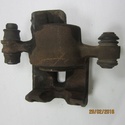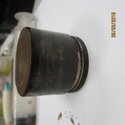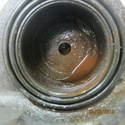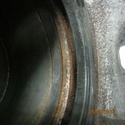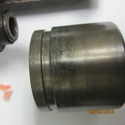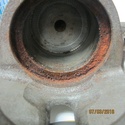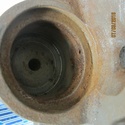Not actually AS brake disks, but to clean them up a bit.
Exhibit A : Drivers side front hub and brakes.
I put the foil on the hub a couple of years ago to stop the wheels rusting on. Seems to have worked, but of course the remains look messy. The rusted remains of a shim have displaced and are stuck against the disk boss. The brakes don’t squeal and I probably wouldn’t care much if they did, so I probably don’t need shims.
Exhibit B : During cleanup.
Other wheel is chocked and the engine run in second gear. (higher gear might have been better but wasn’t sure the diff would like it.) Coke (or beer) can top/bottom (or whole thing crushed) is forced against the disc rim. Whole can crushed has more material but is a bit grabby and top or bottom is probably safer. You could easily get your hand mangled doing this, and it might have been smarter to hold the can section with mole grips.
I wore eye protection but no breathing or hearing protection, both of which would probably have been a good idea. Stray dogs cleared the area as soon as I started.
Exhibit C: Disk after cleanup (this is actually the other side)
servimg.com/view/18149521/128
Exhibit D: “Tools”
servimg.com/view/18149521/129
The bits of TV ariel were used for the side of disk boss, You CAN get a can in there but it feels too risky.
Exhibit E : Caliper guide pin before cleanup.
servimg.com/view/18149521/130
Exhibit F : Caliper parts after cleanup
I don’t know if the “shinyness” on the disk edge is clean steel or adherent aluminium. The latter would be better from a corrosion reistance perspective but I’d guess its a bit of both.
Clearly the steel is still pitted, and it would take a very long time to remove the pits. I’m not using any binder for the aluminium here, because I’m concerned about contaminating the pad surfaces, but that would probably help fill the pits and I might try it. Superglue would probably be safest in this application, but it’ll likely burn off, as would anything else I can think of except maybe ceramics.
I’ve tried various tricks to clean up brake disks for the UK MOT (annual anal vehicle inspection). None of them worked, and this probably wouldn’t either, but it looks more promising than anything else I’ve tried. Electrolysis would probably be better but I don’t have to pass an MOT any more so I havn’t bothered to set that up.
(There were traces of what was probably very old hardened copaslip on the stainless slides, the pad backs, and perhaps some contamination of the pads. I cleaned this off (initially under water) with coke can, foil, scraped the pads with a razor blade, boiled them, dried them off, and then used brake cleaner on them, and they look a lot better, but of course you cant really get all that stuff off.)
